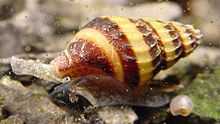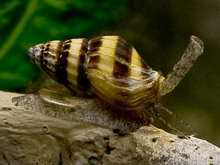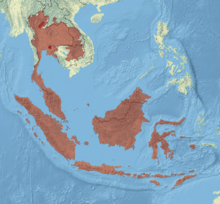Clea helena
| Clea helena | |
|---|---|
 | |
| Clea helena | |
 | |
| Clea helena | |
| Conservation status | |
| Scientific classification | |
| Kingdom: | Animalia |
| Phylum: | Mollusca |
| Class: | Gastropoda |
| (unranked): | clade Caenogastropoda clade Hypsogastropoda |
| Superfamily: | Buccinoidea |
| Family: | Buccinidae |
| Genus: | Clea |
| Subgenus: | Anentome |
| Species: | C. helena |
| Binomial name | |
| Clea helena (Meder in Philippi, 1847) | |
| Synonyms | |
|
Anentome helena | |
Clea helena is a species of freshwater snail with an operculum, an aquatic gastropod mollusk in the family Buccinidae, the true whelks, most of which are marine.[2][3]
Distribution

This species occurs throughout southeast Asia, especially in Malaysia, Thailand and in Lake Toba on the Indonesian island Sumatra.[4][5]
Feeding habits
Like all snails in the clade Neogastropoda, this species is carnivorous. It feeds on worms and gastropods, and is often known as the "assassin snail" for its habit of eating other snails. These snails will often feed on larger snails, often burying themselves and ambushing their prey.[3]
In the aquarium they are very good at hunting down and eating small problem snails that over time take over a tank and appear, generally, when new aquatic plants are purchased. They will also eat high protein foods such as algae wafers and certain sinking food pellets.
Characteristics
This snail will typically grow between 2–3" in size depending on food sources, usually smaller in the aquarium. The shell, which is conical in shape consists of dark brown and yellowish tan bands, leading to some people to refer to this snail as "The Bumble Bee Snail", a name also applied to the marine snail Engina mendicaria. Many aquarists consider this to be one of the more attractive snails available to the hobby.
Reproduction
Clea helena consists of defined male and female individuals which are not capable of sex change. Currently, it is not known how to identify which is male and which is female. Both male and female seem to be the same size and shape. When a male and female mate, they lock together for eight to twelve hours. The female lays several single eggs which are square in shape with a yellow sack. Some eggs do not reach maturity, however fertile eggs usually hatch within a few days, depending on the mineral qualities of the surrounding water.
References
- ↑ The IUCN Red List of Threatened Species. Version 2014.2. <www.iucnredlist.org>. Downloaded on 27 August 2014.
- ↑ Bouchet, P.; Fraussen, K. (2013). "Clea – H. Adams & A. Adams, 1855". World Register of Marine Species. Retrieved March 2, 2014.
- ↑ 3.0 3.1 Monks, Neale (2009). "Assassin Snails and Sulawesi Elephant Snails: Keeping Clea and Tylomelania in the aquarium". Conscientious Aquarist Magazine 6 (4). Retrieved March 11, 2014.
Clea are whelks, most of which live in the sea. Like their marine relatives, Clea are opportunistic carnivores that feed on both live prey and carrion. Among the prey taken are snails, and it is this that has made them popular with fishkeepers. Clea stay partially hidden under the sediment, and if a snail slides past, then quickly (by snail standards) jump into action, chasing their prey and eventually subduing it.
- ↑ "Map of Clea helena". Discover Life. National Biological Information Infrastructure. Retrieved March 8, 2014.
- ↑ (Thai) Boon-ngam P., Sriyarun J., Tanamai S. & Dumrongrojwattana P. (PDF file created 12 January 2010). "การศึกษาเบืองต้ นความหลากชนิดของหอยทากบก และหอยนําจืดในจังหวัดสระแก้ ว Preliminary taxonomic study of land snail and freshwater mollusk species in Sakaeo Province, Eastern Thailand". 10 pp., pages unnumbered. PDF.
External links
| Wikimedia Commons has media related to Clea helena. |